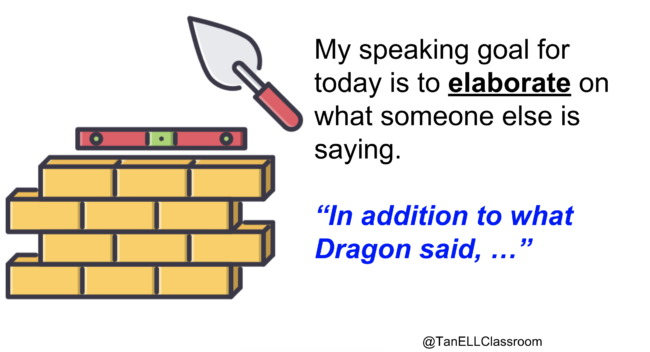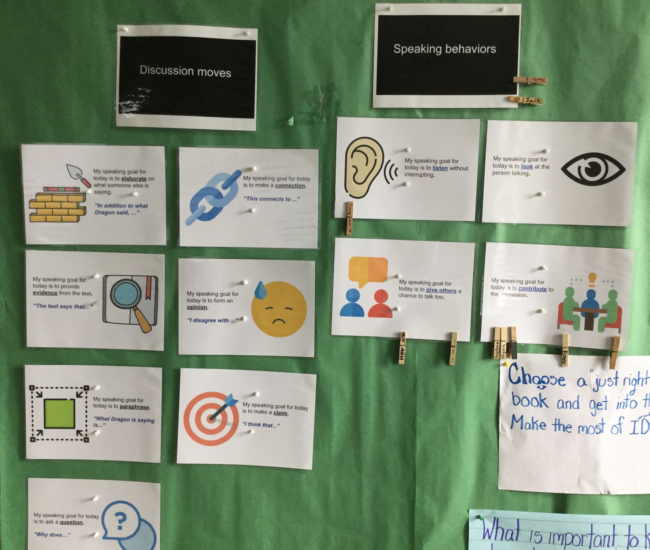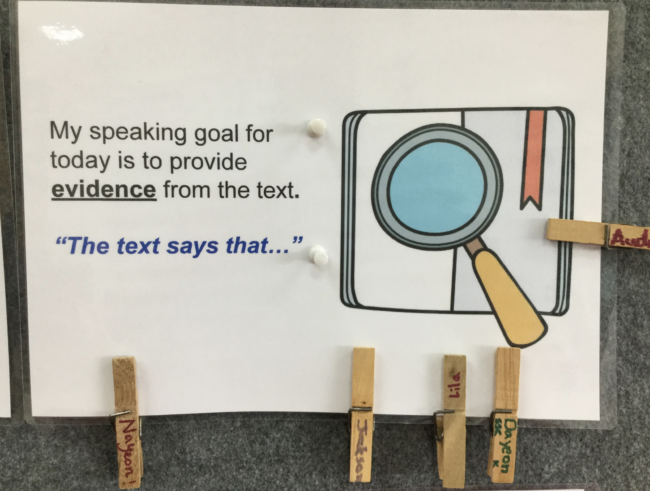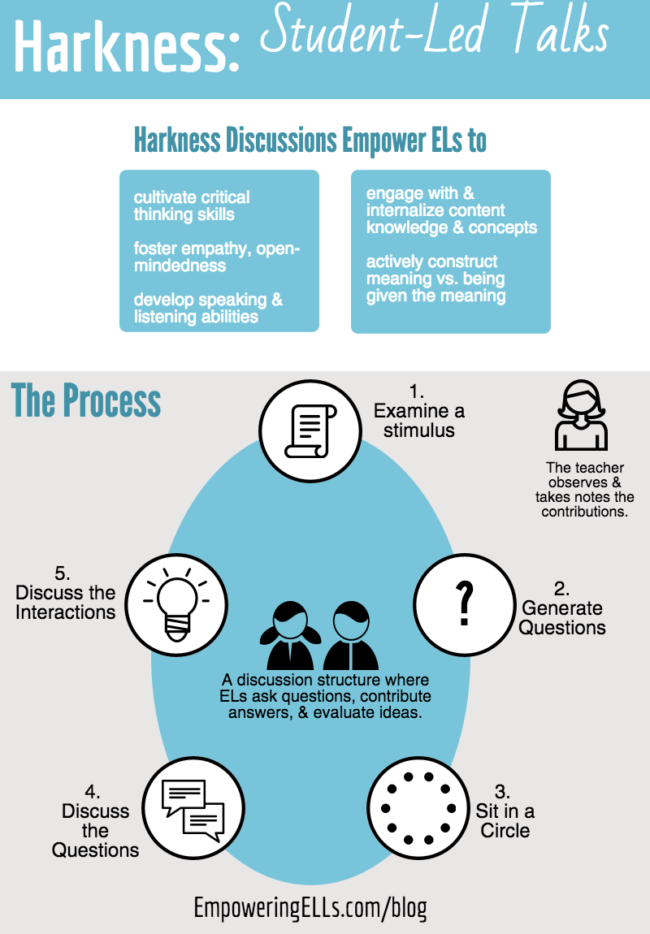This article describes how a Harkness discussion supports ELLs to develop communication and critical thinking skills by discussing a shared text. This article was updated on December 19, 2019
Why is student talk so important?
Talking allows students to construct meaning instead of being told the meaning, and it requires them to do various mental moves when engaging in a discussion. Students can:
- ask for clarification,
- share facts and details,
- defend their ideas,
- make connections, and
- analyze concepts (Bierman, Butler & Reuter, n.d.).
Teachers that empower students to engage in discussions allow them to construct knowledge while simultaneously fostering social and communication skills.
Student-led conversations can be used everywhere
Student-lead conversations are versatile instructional practices because they can be used with large classes, small groups, and in between activities (Smith, Johnson & Johnson, 2005; Huxham, 2005; Jackson, 1995). As Samantha Benett said, “ The person doing the talking is doing the thinking ” (as cited by Salva, 2018).
Furthermore, discussions can be used across content areas since all teachers, regardless of their content expertise, want students to develop critical thinking and communication while also acquiring content (Shen, n.d).
Discussions are particularly helpful for MLs
For 4 reasons:
1. They help students better internalize concepts and form connections (Hestenes, Wells & Swackhamer, 1992). Because of their collaborative nature, discussions support ELs as they work through content rather than simply being given the answer. Discussions contextualize the content through the examples that are brought up during the conversation.
2. They make learning more relevant. When teachers have ELs discuss content and concepts, they make learning a language more relevant because students have to use English to engage in the discussion.
3. They shift instruction from learning a language to using the language.
4. Academic achievement. Talking about content also advances academic language, and, when English is cultivated, ELs’ academic achievement also increases (Gottlieb, 2013; Echevarría, Vogt, & Short, 2008; Kaufman & Crandall, 2005; Chamot & O’Malley, 1994; Mohan, 1986).
In short, there’s a clear positive, reciprocal relationship between discussing content and language acquisition. As one grows, so does the other.
Why teacher-centered discussions don’t work
A typical teacher-centered discussion checks only for students’ understanding, as shown in the diagram below.
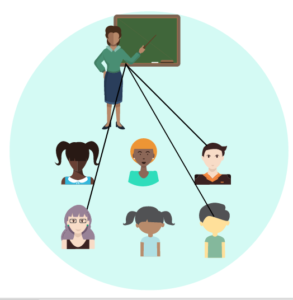
Usually, when I would ask a question, a single student would answer, while the other 25 just zoned out. I would evaluate the answer, assess the correctness and then move onto another question. If the response was incorrect, I would ask it again and search for another student to respond.
If you were bored just reading me type that, imagine how your students feel trying to engage with it. It wasn’t only boring, it also failed to help ELs generate their own questions, which are an important sign of higher-level thinking.
Who does all work in a discussion like this? Me. Or that one smart kid. Certainly not the students who needed it. Clearly, my antiquated discussion strategy was ineffective at building my ELs’ ability to think and communicate authentically.
They were playing a monotonous guessing game, and they usually lost.
Why student-centered Harkness Discussions work
I am not exaggerating when I say that the Harkness Discussion has completely transformed my teaching. The Harkness Discussion (also called the Harkness Method or Harkness Table) originated at Phillips Exeter Academy, ranked as the top boarding school in the United States by Business Insider Magazine.
That same publication also followed up with an article entitled “Why Classes at Phillips Exeter are Different Than at Any Other Private School”. They’re different because the Harkness Discussion places the thinking work on students themselves:
- posing questions,
- providing answers, and
- evaluating ideas.
The move away from the teacher-led discussion to student-controlled conversations invigorated the learning experience, principally because the desire to talk came from students asking each other questions. It was both surprising and exhilarating to find.
Here is a quick tutorial on how to facilitate a Harkness discussion.
You might be thinking, “This is just a normal student discussion about the text.” For me, I see:
- student-centered instruction
- students listening to each other
- students answering each other’s questions
- students strengthening interpersonal skills
- students developing critical thinking skills
Implementing a Harkness Discussion
Step 1: Examine a Stimulus
If students are doing all the talking, what’s the teacher supposed to do? Our role as educators is to give students a focus for their discussion. The focus is often a stimulus such as a written text, a video, a song, or a performance. A stimulus can even be an activity or an event.
I find the text for students to discuss, which is arguably the most important role as a discussion becomes stagnant when a poorly-chosen text does not drive thinking and questioning. A stimulating text, in contrast, will produce many questions about the events and concepts.
For example, during our interdisciplinary unit with the Humanities class where we studied the concept of justice, students were fascinated by an article reporting on how some states in the U.S. refused transgender students to use the bathroom that matched their self-identified gender. It stimulated a lot discussion that engaged the students on multiple levels.
In an English class, we often stop to discuss a significant chapter or an excerpt from a text. While all students should have access to the text at least the night before, I have found that it is best to discuss a text immediately after we have read it in class because it’s fresher in students’ memories and guarantees that all students have attempted to access it.
If we don’t ensure that all students have processed the text, we guarantee that only some students will participate.
Step 2: Generate Questions
Next, I have students generate questions on our classroom Padlet. The only caveat is that they must NOT know the answer to their questions. We want the discussion to be driven by the ELs’ desire to seek answers and construct meaning.
Real questions create engaging discussions because they require students to pay careful attention to each other’s responses. You might even help structure this step further by providing sentence starters such as:
- Why did…?(infer)
- Which is most…? (evaluate)
- How does this connect to…? (apply)
- What is the meaning of…? (interpret)
- How did X feel about…? (empathize) (Zwiers & Crawford, 2011)
Step 3: Sit in a Circle
In each classroom at Philip Exeter, there was a large wooden oval table where it is easy for the students to face one another in conversation. Facing each other rather than the front of the room fostered more engaging student-to-student conversations.
Sitting together in a circle also prevented less confident or less prepared students from hiding in a row of desks.
However, most classrooms in the world do not have the luxury of a cherry wood table that can fit 15 people plus the teacher. When I first implemented Harkness into my New Orleans public school, I was only equipped with those horribly uncomfortable chairs connected to small desks.
Nevertheless, I could still recreate a Harkness Discussion using smaller groups as shown in the image below. I would usually direct my students to form groups of 4 or 8, as anything smaller than a group of 4 would often produce less dynamic conversations.
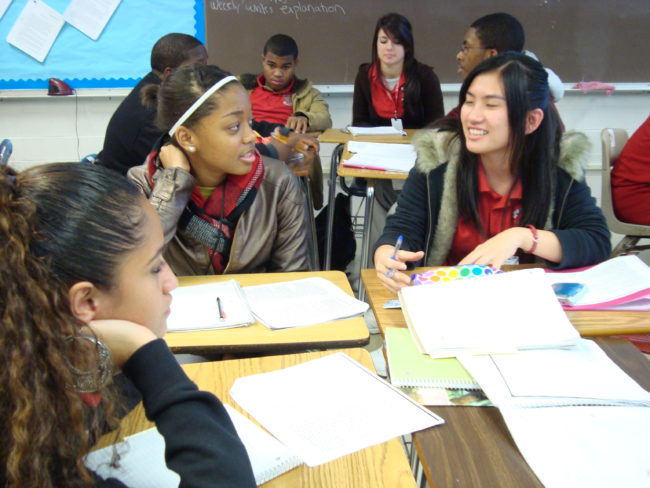
You should sit outside the circle to teach students that they should be addressing one another, not you. Once the students internalize the process, you can return to the circle as an observer, but not as an active participant. I’m usually writing down students’ responses and making note of their contributions. More on the teacher’s role below.
Please consider using a Fishbowl Harkness Discussion with a large class
If you have a large class of 30 plus students, consider forming a Fishbowl Harkness Discussion instead. Half the students are engaged in the discussion directly and form the inner circle.
The remaining students are given an observation task and form the outer circle. For example, you can tell them to observe the contributions of one person in the inner circle.
Ask the students in the outer ring to look for:
- Who talked to the most?
- What kinds of contributions were made (questions, clarifications, connections, opinions, etc.)?How relevant were their assigned student’s contributions?
- How respectful did the student disagree with opposing ideas?
- How often did the student use textual evidence to support their ideas?
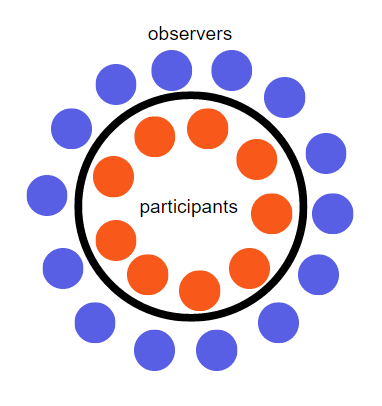 A Fishbowl Harkness Discussion is great for a large class because all students are either actively engaging in the discussion or observing the participants.
A Fishbowl Harkness Discussion is great for a large class because all students are either actively engaging in the discussion or observing the participants.
Please note: Observation is not a cop-out. First and foremost, because observing practices meta-cognitive thinking, the questions they’re thinking about are substantial and evaluative.
Moreover, students’ reflections help those in the inner circle reflect on how well they engaged in the discussion. It’s a form of student-based feedback.
Tip: I often place the students with more developed language skills in the inner circle first to model the type of contributions for the outer circle to help those who may need the peer-based modeling.
Step 4: Discuss the Questions
Once I’ve projected the Padlet questions on the board, anyone can ask the first question. Usually, one question will lead to another, so after the initial look at the Padlet questions, we don’t have to return to them until there’s a lull in the conversation.
Your role is as a referee, not a leader
At first, students tend to look to me to respond after they pose a question because they’re so used to a traditional discussion method. In an effort to break their learned-helplessness, I simply remain quiet and let the uncomfortable silence grow until students respond. No one likes uncomfortable silence.
Because my younger students need more support understanding how to have a classroom conversation, I refer them to this graphic from Jeff Zwiers and Marie Crawford’s book entitled, Academic Conversations: Classroom Talk that Fosters Critical Thinking and Content Understanding (2011). It helps ELs engage in academic conversations because the different forms are clearly identified and associated with images.
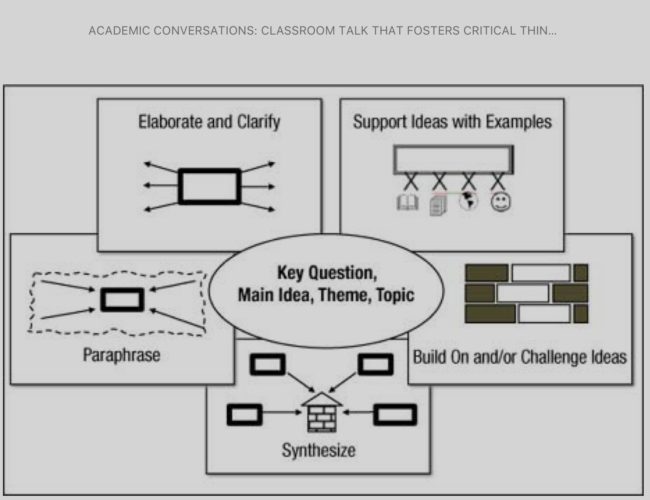
No longer the lead participant, the teacher’s role is now as a referee.
While students are free to express their ideas and opinions, sometimes they turn against one another instead of one another’s ideas. As a referee, I intervene when a person is attacked instead of their ideas.
Just as a referee does not tell an athlete how to play but makes sure that the rules are followed, your role is to make sure that students follow the discussion structure and interact with each other respectfully.
The role that I play most frequently is actually that of a bird watcher: unobtrusively entering into the environment and trying not to disturb the birds as they go along their business.
Just like bird watchers, we need to quietly and observantly wait for those moments when our patience is rewarded with a glimpse of deep thinking, ideas being connected, and insight being formed.
Let the silence do the work.
Now that I’m working at an elementary school, I have to scaffold Harkness for students more than I did when in secondary school. To do that, I have created speaking cards like the one below.
I tell my students to pick a goal before we engaged in the Harkness. Some of the cards have a sentence starter to help them when they are speaking. Others are just reminders of the speaking behaviors expected during student-led discussions. Once they choose a goal, they clip their clothespin to the bottom of the goal card.
At the end of the discussion, if they felt like they have achieved their goal, they move the pin to the top of the card. If they have met it partially, then they move the pin to the side of the card. If the goal was not attempted, then they leave the clothespin at the bottom.
Step 5: Discuss the Interactions
Option 1: From notes drawn with pen and paper
Traditionally in our Harkness Discussions, I draw a circle and write the names of students on the place where they are sitting. Then, I draw an arrow between the person who asked the question and the person who has responded and note either what they said or the type of thinking they used.
Below are the notes of Ms. Suzi, a 12th grade English language teacher, which was taken when her seniors talked collaboratively about an article discussing medical marijuana use.
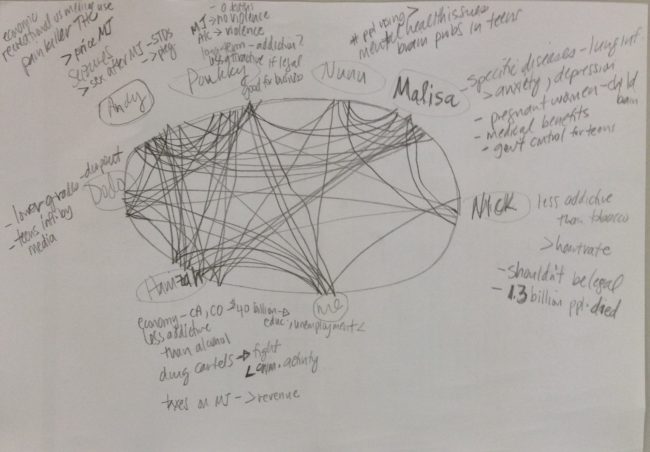
Midway through the discussion or at its conclusion, I like to show students the notes that I took. This tracker then becomes a visual tool to show students themselves how they are participating. I also point out if students made connections to ideas, identified a contradiction, posed a genuine question or asked for clarification.
This is a form of praise for students who have made these types of contributions and encouragement for other students to do the same. The ability to discuss in those ways is so important because a collaborative Harkness Discussion mirrors that of productive adult conversations that occur in board rooms, legislative halls, community centers, or online conference calls all over the world.
Option 2: From notes drawn electronically
As of this school year (August 2016), I’ve changed the way I take notes in a Harkness discussion. I find that I simply cannot write fast enough, or I find my handwriting almost illegible to decipher afterward.
So my new approach is to open a Google Drive Word Doc, and I quickly write the ideas students share. Each student has a cell within the table. I simultaneously categorize them as collaboration, question, explain, paraphrase, or question to show the type of thinking.
Moreover, this document can be projected at the end of the talk, and we can have a conversation about the discussion – so meta!
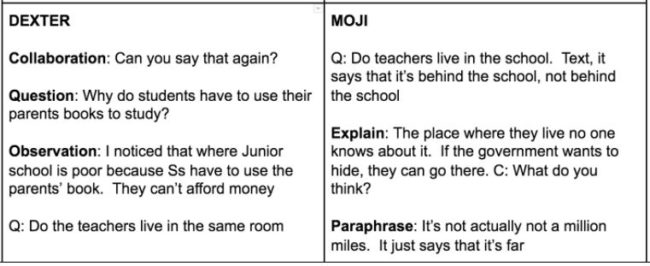
Socratic Vs. Harkness
At this point, you might be wondering: how is a Harkness Discussion different from a Socratic Seminar? Many teachers are already familiar with the latter – a discussion method grounded in providing students with demanding, open-ended questions. Teachers then instruct their students to collaboratively discuss the answer.
I will admit that there are some great benefits to Socratic Seminars. The teacher-created questions are effective in helping students develop critical thinking skills, practice communication skills, and cultivate a deeper understanding.
However, those questions are also its Achilles’ Heel. In a Socratic Seminar, students are there to collaboratively answer the teacher’s questions with their peers. But, in a Harkness discussion, students are expected to formulate questions themselves. In discussions, forming questions is as important as answering them.
When students come to a Harkness Discussion with questions, they’re more engaged and want others to help answer their questions. Teacher Mary Tedrow feels the same way I do about the inability of Socratic Discussions to inspire our students. She writes:
“the students were not wrestling with ideas by listening to each other and pressing for more information or a new angle on the argument. They kept dropping compelling questions as they surfaced one new idea after another. I wanted them to see how much fun it is to play with an idea.”
It is fun to play with an idea. And, moreover, when students ask questions, we also teach them that questions are often more valuable than answers because of the thoughts that questions provoke.
Takeaways
After teaching ELs the Harkness Discussion, I see them becoming more independent learners because the habits of collaborative discussion have been scaffolded and modeled for them.
I am often just struck by students’ thoughtfulness and their growth through this practice. Their conceptual understanding of a topic deepens and their academic language grows through multiple discussions.
The content becomes contextualized and the thinking done while talking is made visible. And when something is visible, it can be observed and followed.
Next Post
The next article will be about implementing a micro-writing structure that develops ELs’ writing stamina, supports the synthesis of content information, and cultivates the writing thought process.
Have you used Harkness Discussions with your students? Share your tips and tricks in the comments below.
Bibliography
Bierman, P., Butler, E., & Reuter, J. (n,d). Earth Hazards: An introductory class combining the sciences of education and geology at the University of Vermont. Retrieved from http://www.uvm.edu/~earthhaz/hazards/Discussion.html.
Brookfield, S. & Preskill, S. (2005). Discussion as a Way of Teaching: Tools and Techniques for Democratic Classrooms. San Francisco: Jossey-Bass.
Chamot, A. U., & O’Malley, J. M. (1994). e CALLA handbook: Implementing the Cognitive Academic Language Learning Approach. Reading, MA: Addison-Wesley.
Echevarria, J., Vogt, M. E., & Short, D. J. (2008). Making content comprehensible for English learners: The SIOP® model (3rd ed.). Boston: Allyn and Bacon.
Fisher, D., Frey, N., & Rothenberg, C. (2008). Content-area conversations: How to plan discussion-based lessons for diverse language learners. Alexandria: Association for Supervision and Curriculum Development.
Gottlieb, M. (2013). Essential Actions: A Handbook for Implementing WIDA’s Framework for English Language Development Standards. Madison: Board of Regents of the U of Wisconsin System.
Hattie, J. (2012). Visible Learning for Teachers: Maximizing Impact on Learning. London: Routledge.
Huxham, M. (2005). Learning in lectures Do ‘interactive windows’ help?. Active learning in higher education, 6(1), 17-31
Hestenes, D., Wells, M., & Swackhamer, G. (1992). Force concept inventory. The physics teacher, 30(3), 141-158.
Jackson, T., & Ed, M. (1995). More activities that teach. Red Rock Publishing.
Kaufman, D., & Crandall, J. (Eds.). (2005). Content-based instruction in primary and secondary school settings. Alexandria, VA: Teachers of English to Speakers of Other Languages.
Menninga, A. (2015, June 10). “If you want them to HEAR it, you talk. If you want them to LEARN it, THEY TALK.” Retrieved from http://mindwise-groningen.nl/if-you-want-them-to-hear-it-you-talk-if-you-want-them-to-learn-it-they-talk/
Mohan, B. (1986). Language and content. Reading, MA: Addison-Wesley.
Shen, Danxi. “Discussion.” Ablconnect. Havard University, n.d. Web. 15 July 2016.
Smith, K. A., Sheppard, S. D., Johnson, D. W., & Johnson, R. T. (2005). Pedagogies of engagement: Classroom‐based practices. Journal of Engineering Education, 94(1), 87-101.
Wilen, William W. (2004). Refuting Misconceptions about Classroom Discussion. The Social Studies 95.1, 33-39.
Zwiers, J., & Crawford, M. (2011). Academic conversations: Classroom talk that fosters critical thinking and content understandings. Portland, Me.: Stenhouse.

